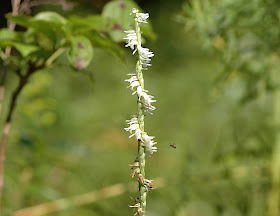Just one county south, and I never go anywhere down there. Thanks to Dave Enterline, a former colleague for showing me 150 acres he keeps in the Rural Preserve Program (different from CRP). We wandered from creek side habitats to bottomland forest, oak-hickory uplands, ponds, vernal pools, pine plantings, and open fields. Here are just a few things I observed.
In the dew of the morning shade, this Mistflower appears like purple icicles.
Also found in the shade of the forest edge were these cotton candy-like spider webs. I've never ventured much into the spider world, but like any curious naturalist, I had to venture inside to see who constructed this web.
I believe this little critter is a member of the Sheetweb Spiders. A female Filmy Dome Spider, Neriene radiata.
Sitting motionless on a thistle, this immature Leaf Beetle looks as if it's preparing to pupate. With color and markings similar to immature Ladybugs, these beetles appear more like a swollen tick or bursting maggot than the ladybird beetles.
Sitting in an open field was this Ladies Tress Orchid. These can be difficult to get to species. Notice how the flowers twist up the stem like a candy cane or barber pole. Knowing how many rows of twisting flowers you have is the first thing to look for. This has a SINGLE row of flowers, which eliminates half the species immediately. Seems a little wasp was as curious as I was.
Next look at size, blooming period, habitat, and whether or not it has leaves at blooming time. This one did have lots of long narrow leaves, both on the stem and basally. There are a number of keys to this group, some more tolerable than others, none of which promise an easy outcome.
What do ya say Vern? Standing over two feet tall, and seeing the flowers lack any green markings, this appears to be Narrow-leaved Ladies Tress, Spiranthes vernalis. This species is uncommon in Ohio, but has been recorded down here in Meigs County.
Sitting right next to the ladies tress was this hawkweed. Another group that takes a little work, especially since some hybridize.
This plant was over four foot tall. Most noticeable was the lack of any leaves throughout the middle portion of the plant, making this Hairy Hawkweed, Hieracium gronovii. A similar hairy species, Rough Hawkweed (scabrum) has leaves on the entire stem.
No matter how often you get out, or how long you spend in the woods, photography is still based on one important factor, luck! While exploring a field, this guy just happened to land in front of me. This is the Giant Robber Fly, Promachus rufipes. Sometimes called the red-footed or red-legged robber, it's the largest in our area.
Robber Flies are recognized by three main characters. The long tapering torpedo body, the long over-sized legs, and the fu-man-chu beard. In some species the enlarged hump on the thorax may also work. We all know a honey bee when we see one, so consider just how big this fly is when looking at the bee.
So much for that basket of pollen. Robber flies are known for attacking their prey in mid air, or stealing it from another predator. This family commonly seeks out bees and wasps, but don't worry, out pollinator populations are in no danger of being decimated by these guys. Those eyes alone are enough to give you chills. Reminds me of some sci-fi alien.
Restricted to southern Ohio, the often overlooked Elephant's-foot is easy to recognize by the always triad set of upper leaves. To my knowledge this is a county record.
By mid afternoon, with Dave and I drenched in sweat, it wasn't long before the butterflies started landing on us. Of particular note was this snout butterfly.
Snout Butterfly? I can't imagine where the name came from.
Of all the things I saw that day, (and there were plenty more) the littlest thing caught my attention the most, go figure. Inside this morning glory (Bindweed actually) was this beetle less than a quarter inch. Is it me, or does anyone else think Scary Movie? Turns out it is a Bruchid Seed Beetle, Megacerus discoidus, and I had to get help on this one. You see you can't always rely on Google. When I punched in "orange and black beetle" this is what I got.

















Very interesting post, Dennis! Love the reference to Google search! Very funny!
ReplyDeleteAwesome blog!! I believe the leaf cutter beetle larvae you identified as nearly pupating is actually a lady beetle pupa.
ReplyDelete